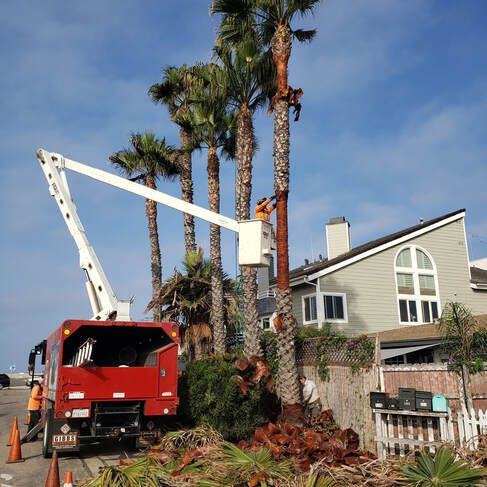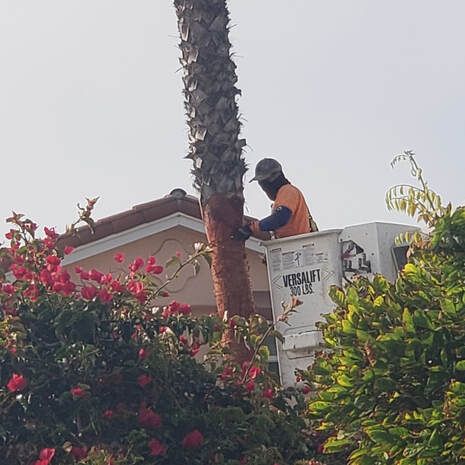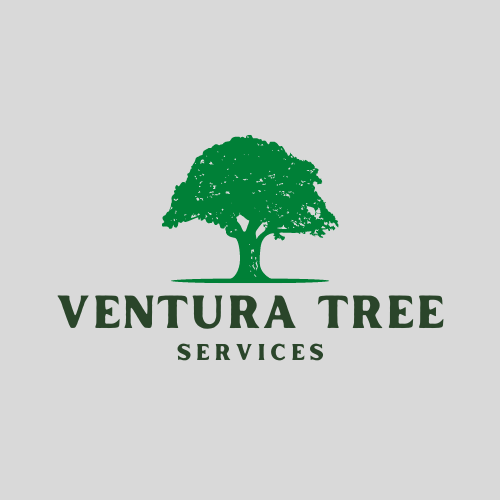VENTURA COUNTY
PALM TREE PRUNING / SKINNING SERVICE
Call to Consult or to Make Your Appointment Now:
(Click to Call on Mobile Device)
PALM TREE SKINNING & PRUNING SERVICES VENTURA
We are experts on skinning palm trees. Some think that palm trees are very Palm trees are "low maintenance." Actually, most palm trees need regular pruning / trimming to keep their attractiveness and safety for your yard. Another myth is that cutting back or trimming a palm tree might make it grow back faster. This is not the case. Radical and extensive palm tree pruning doesn’t help your tree and can actually harm the health of your trees. Like any other type of tree, trimming palm trees, must be done deliberately and carefully. You need to hire professionals who know the best methods for your palm tree pruning.
Call us to help you with the skinning of palm trees, removing dead or sickly looking palm fronds. Removing these old palm fronds by trimming palm plants prevents breakage damage -- both to your trees and to other property. Having a professional help you also allows us to ensure that your palm tree is not a nest for rats, scorpions and other vermin. We can also trim your tree if and when it becomes a hazard, either from fire (when it is too close to structures, or other hazards like a tree blocking your views from your driveway. If it blocks the views from your driveway or sidewalk, you’ll want Ventura Tree Services to prune / skin your palm tree.
When one cuts back a palm tree, we often see homeowners and less experienced firms remove most of the healthy fronds, which makes the tree weaker and unhealthy. We leave as many green fronds as possible on a palm palm tree. Palms need their green fronds where they produce a food for the tree so that the plant can grow. We also advise against trimming / pruning palm plants for purely cosmetic reasons, (i.e. into shapes, etc.)
Palm Tree Skinning in Southern California: Essential Techniques and Best Practices
Palm tree skinning in Southern California is the process of removing the outer layer of dead or damaged palm fronds to maintain tree health and appearance. This practice helps prevent pest infestations and promotes new growth, making it essential for proper palm tree care in the region.
We often see palm trees with shaggy or decaying bark, which can lead to problems if not addressed. By skinning the palm tree, we ensure it stays strong and aesthetically pleasing, especially in the dry climate where issues like fungal growth can take hold.
Understanding the right methods and timing for skinning is key to avoiding harm to the tree. We’ll explore how to do this correctly and why it matters for palm trees thriving in Southern California’s environment.
What Is Palm Tree Skinning?
Palm tree skinning involves the careful removal of the dead outer layers on the trunk of a palm. This process requires specific tools and techniques to avoid damaging the tree while improving its appearance and health.
Definition and Purpose
Palm tree skinning is the process of stripping away the dried, brown, or decaying outer fronds and bark from the trunk. This helps expose the core trunk, revealing a cleaner, smoother surface that is less vulnerable to pests and disease.
The purpose is both aesthetic and functional. Removing dead material reduces potential hiding places for insects and fungus. It also prepares the tree for treatments like fertilization or pest control. In Southern California, where many palms face heat and pests, skinning is an important maintenance step.
Common Techniques
We use tools like hand knives, pole pruners, and in some cases, mechanical peelers for skinning. The process requires careful trimming of dead fronds without cutting into the living tissue beneath.
Skinning often starts at the base and moves upward in small sections, making sure not to damage the soft trunk core. Some professionals use pressure washing after skinning to remove residual dirt and debris. The cleaning enhances tree health and appearance. Timing the process is key; skinning during dry seasons is preferred to avoid fungal infections.
Key Benefits
The main benefits include improved tree health, decreased risk of pest infestations, and a visually appealing trunk. By removing old, dead material, we limit places where insects like palm weevils can breed.
Skinning also helps detect early signs of disease or decay, allowing for timely treatment. Visually, homes and landscapes gain a more polished and well-kept look from freshly skinned palms. Regular maintenance through skinning extends the palm’s lifespan in Southern California’s climate.
Why Skin Palm Trees in Southern California?
Skinning palm trees in Southern California addresses specific environmental and aesthetic challenges. The practice helps us manage heat stress, combat pests common in the region, and improve the overall appearance of palm landscapes.
Climate Considerations
Southern California’s dry, warm climate exposes palm trees to intense sun and fluctuating temperatures. Skinning removes old, dead fronds and excess biomass that can trap heat near the trunk, reducing the risk of fungal growth and rot.
This practice also improves air circulation around the tree base, which helps prevent moisture buildup. By managing these factors, we protect palms from stress-related damage caused by heat and drought conditions typical in the region.
Local Pest Management
Palm skinning is essential for controlling pests such as palm weevils and scale insects, which thrive under dense frond layers. Removing dead or dying material reduces breeding grounds, limiting pest populations before infestations worsen.
Maintaining a clean trunk also improves the effectiveness of treatments. Insects and pathogens don’t find shelter as easily, making skinning a proactive step in integrated pest management for Southern California palms.
Enhancing Landscape Aesthetics
Skinning creates a sleek, uniform trunk that highlights the natural shape of the palm. It removes unsightly dead fronds and debris, presenting a well-maintained appearance favored in Southern California’s landscape design.
This improved look can increase property value and curb appeal, especially in residential and commercial areas. Consistent skinning also promotes healthier growth, resulting in a more vibrant canopy that complements the climate and setting.
Identifying When to Skin Palm Trees
We need specific cues from palm trees and their species to know when skinning is necessary. These cues help prevent damage and ensure the tree remains healthy. Timing also varies depending on the type of palm.
Visual Signs Palm Trees Need Skinning
We look for dead or brown leaf bases that create a thick, unsightly "skirt." This skirt can trap moisture and pests, leading to decay. Another sign is the presence of fungal growth or insect nests under the old fronds.
If the trunk looks uneven due to peeling bark or has excessive old fiber buildup, it’s time to skin. We avoid cutting green or healthy tissue to prevent stress or disease. Regular inspections every six months help identify skinning needs early.
Recommended Timing by Species
Timing varies by species, especially in Southern California’s climate. For Queen Palms, it’s best to skin in late spring before the growing season peaks. This reduces the risk of sap bleeding and stress.
Canary Island Date Palms should be skinned annually in summer when the tree is fully active, helping to remove dead material before fall. For California Fan Palms, minimal skinning is advised, doing so only when the skirt is heavy or diseased, typically in early summer.
We adjust timing based on weather and tree health to avoid harm.
Methods and Tools for Palm Tree Skinning
We prioritize safety and efficiency when skinning palm trees, which requires specific equipment and techniques adapted to the unique structure of these trees. Understanding both protective gear and the differences between manual and mechanical methods helps us choose the right approach for each situation.
Standard Safety Gear
When working on palm tree skinning, we always wear protective gloves made from cut-resistant materials to shield our hands from sharp fronds and rough surfaces. Safety goggles guard our eyes against dust and debris, which are common during the skinning process.
We use hard hats to prevent injury from falling debris. Sturdy, non-slip boots provide traction when climbing or walking around the base, reducing risk of slips or falls. In some cases, chainmail arm guards are worn to protect forearms from scratches while cutting.
Harnesses and climbing ropes are essential when working at height. We inspect all safety equipment regularly to ensure it meets OSHA standards for fall protection.
Manual vs. Mechanical Techniques
Manual skinning involves using hand tools like pruning saws, machetes, and drawknives. This method allows precise removal of fronds and tough bark, especially useful in tight or delicate areas. Manual tools require physical effort and skill but offer better control.
Mechanical tools include powered saws and specialized peelers designed to strip the palm's outer layers faster. These tools increase efficiency on larger palms but can risk damaging the tree if not used cautiously.
We choose manual methods when preservation of the tree’s health is critical or access is limited. Mechanical techniques suit larger-scale operations where speed is necessary but still demand careful handling to avoid harm.
Selecting Qualified Palm Tree Skinning Services
Choosing the right palm tree skinning service requires careful attention to expertise and pricing. We must identify specialists with the proper credentials and understand how costs align with the scope of work and local market rates.
What to Look for in a Specialist
We need to ensure the specialist holds proper licenses and insurance. This protects us from liability and ensures professional standards.
Experience with palm tree skinning specifically is critical. Not all tree services have the knowledge or skill to handle palm trunks without causing damage.
Checking references or reviews from previous clients informs us about reliability and quality. We should look for consistent positive feedback on delicate handling and clean results.
Equipment quality also matters. Proper tools designed for palm skinning minimize risk to the tree and improve efficiency.
Understanding Service Costs
Pricing usually depends on palm height, trunk thickness, and the level of existing damage or pest infestation.
We should request detailed quotes that include labor, disposal of debris, and any follow-up treatments.
Local market rates vary; in Southern California, expect to pay between $150 to $400 per palm, depending on complexity.
Beware of significantly low bids as they may cut corners or lack insurance. Transparent pricing and written estimates help avoid unexpected charges.
Legal and Environmental Considerations
We must carefully manage the skinning of palm trees to comply with local laws and minimize harm to the environment. This involves navigating specific regulations and ensuring that we protect native animal species during the process.
Southern California Regulations
In Southern California, palm tree skinning is regulated by city and county ordinances, which vary widely. For example, Los Angeles requires permits for trimming and skinning trees on private property, especially if the trees are considered protected species.
Violating these regulations can result in fines up to $1,000 per tree. We also must follow the California Coastal Act and local planning rules that restrict tree removal near coastal areas.
Proper documentation and adherence to municipal codes are essential before beginning any skinning project. This includes notifying local authorities and sometimes submitting environmental impact assessments.
Protecting Native Wildlife
Palm trees provide homes for many native species, including bats, birds, and insects. Before skinning, we need to inspect for active nests or roosting sites to avoid disturbing wildlife during sensitive periods like breeding seasons.
Certain species are protected under the Migratory Bird Treaty Act and the California Endangered Species Act. Disrupting these animals or their habitats can lead to legal penalties.
We recommend timing skinning activities outside the nesting season and working with licensed wildlife professionals when necessary. This approach helps sustain local biodiversity and complies with wildlife protection laws.
Aftercare and Ongoing Palm Tree Maintenance
Proper care after skinning is essential to help palm trees recover and stay healthy. We must also maintain scheduled upkeep to prevent future issues and support steady growth.
Post-Skinning Care Tips
Immediately after skinning, we should apply a wound sealant or fungicide to exposed areas to reduce the risk of infection. Avoid watering the tree for 48 hours to let the skinning wounds dry properly.
Monitoring for signs of stress such as discoloration or wilting is important. If we notice these symptoms, adjusting water and nutrient levels promptly helps the tree recover faster. We should also keep debris away from the trunk base to prevent pests and diseases.
Pruning dead or damaged fronds after skinning is necessary but must be done with clean, sharp tools to avoid additional injury. Regular inspections for damage or infections ensure early intervention.
Seasonal Maintenance Routines
We schedule regular inspections of palm trees at least twice a year, focusing on nutrient deficiencies and pest infestations. Fertilization with a specialized palm formula rich in potassium and magnesium supports strong growth.
During summer months, watering frequency should increase since palms use more water in heat. In contrast, in cooler months, we reduce watering to avoid root rot. Pruning schedules align with growth cycles to minimize stress and maximize health.
We also recommend applying preventative pest treatments seasonally to control common pests like palm weevils or spider mites before infestations develop. Keeping records of maintenance activities ensures consistent care over time.
Common Mistakes to Avoid
One frequent mistake we see is over-skinned palms. Removing too much bark damages the tree’s ability to transport nutrients, weakening its health. We must leave enough fibers intact to support natural growth.
Another issue is using improper tools. Dull or incorrect blades can cause uneven cuts and increase the risk of injury to both the worker and the palm. We rely on sharp, specialized knives for clean removal.
Skipping protective gear is risky. Gloves, eye protection, and sturdy clothing reduce the chance of injuries from sharp tools and falling debris. Safety should never be compromised.
We should avoid ignoring local regulations. Some areas in Southern California have rules about palm maintenance to protect native species. It’s essential we check and follow these guidelines.
Trying to skin palms during extreme weather conditions is also a common mistake. High heat or heavy rain makes the task unsafe and can harm the palm. We wait for stable, dry weather when possible.
We have observed a steady increase in the use of mechanical tools for palm tree skinning. These tools improve efficiency and reduce physical strain compared to traditional hand methods.
Environmental concerns are influencing how we approach palm tree skinning. There is a growing emphasis on minimizing damage to the tree’s core and avoiding unnecessary removal of fronds.
Many professionals now follow seasonal timing to optimize the skinning process. We often recommend skinning during dry months to reduce the risk of pest infestations and fungal growth.
Trend Description Benefit Mechanical Tools Use of saws and tractors Faster, less labor-intensive Conservation Practices Selective removal of fronds Healthier trees, less waste Seasonal Skinning Skinning in dry seasons Reduces pest and disease risk We also notice increased awareness around safety protocols. Workers use protective gear more consistently and adhere to regulations aimed at preventing accidents during skinning.
Technology plays a larger role now. Drones and cameras sometimes assist in assessing palm health before skinning, helping us decide the best approach with less guesswork.


